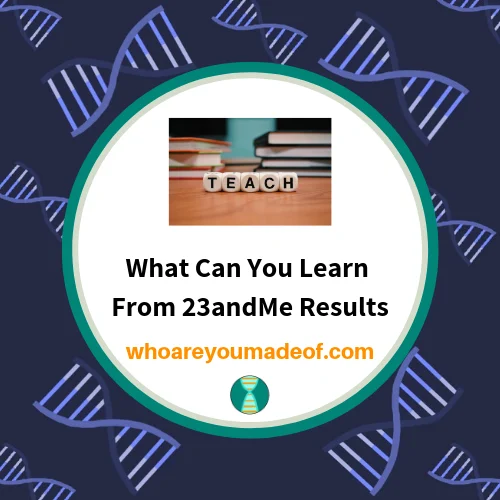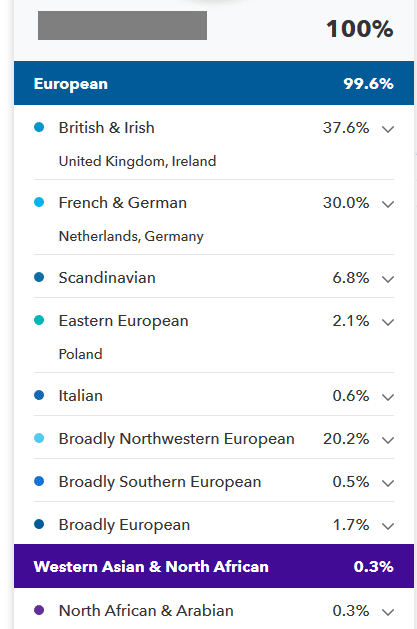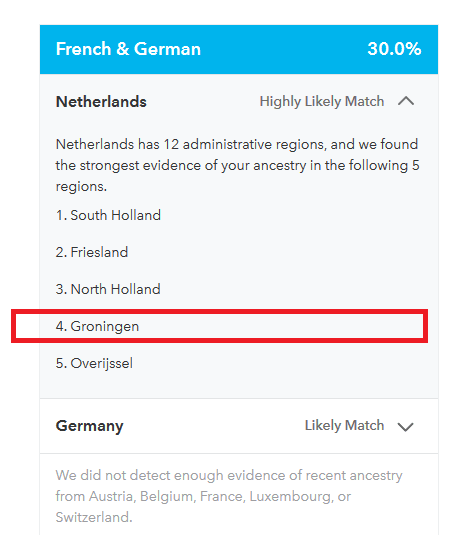Are you wondering what you can learn from 23andMe results? The answer is SO MUCH. Whether you are interested in your distant ancestry, are searching for a living relative, or want to know where your recent ancestors likely lived, the 23andMe ancestry test has got you covered.

To write this post, I decided to make a list of my favorite things that you can learn from your 23andMe results. I'm so excited about writing this list that I can hardly decide where to begin. 23andMe offers some really amazing information in their results.
Are you ready?
23andMe can show you which regions of the world most closely match your DNA
We inherited DNA from all of our most recent ancestors. 23andMe is able to compare the DNA that we inherited from our ancestors going back as far as 6-8 generations (and sometimes even much further back!) to DNA of people living in 175 regions around the world.
Once they finish the comparison, we get a really cool list of percentages that tell exactly which region (and sometimes even a sub-region within the larger region) matches our DNA.
The image below is from my dad's 23andMe test.

My dad has great-grandparents from Germany and the Netherlands, which are very clearly noted in his results. I was astounded at the accuracy of his results. For the regions that match us at high percentages, we are able to click through to learn more details about our match to the region.
This leads me to the next cool thing that we can learn from 23andMe results.
23andMe can sometimes help you discover the specific part of a country where your ancestors lived
Even better than just being able to tell us the country (or broader geographic region) where our ancestors lived, sometimes a region shows up so clearly in our DNA that they are able to pinpoint the county (or administrative region) where our ancestors lived.
For example, most of my dad's ancestors were born in Gronigen. To my surprise, I was able to pull up a list of provinces within the Netherlands that match my dad's DNA:

I don't know where all of my dad's ancestors from the Netherlands were born, naturally, but I think it is amazing to have this really helpful list that might be able to help me narrow things down in the future.
23andMe can help you discover living relatives
I had both of my parents do a 23andMe ancestry test in order to help with my family tree research. My mom has 1085 DNA matches and my dad has 1082 DNA matches. All of these people are related to my parents, which means that by having my both of my parents test, I have discovered 2,167 genetic relatives.
The image below shows how the DNA matches show up on the DNA relatives list. You can see how many matches you have, the estimated relationship, and how many DNA segments you share.

There are numerous ways to sort DNA matches on 23andMe, so if I am looking for a particular person, or someone with a particular surname, I can easily sort it out.
Yes, 23andMe does have a chromosome browser
This is my absolute favorite part of 23andMe results. Well, along with the list of DNA matches. Maybe I'm a nerd, but I absolutely love to be able to compare DNA matches using the 23andMe chromosome browser.
Using the browser, I am able to see the exact amount of DNA that my parents share with their matches in centimorgans, as well as the exact location on the chromosomes where the shared DNA segments are located.
I can even compare my DNA matches with each other in order to triangulate DNA segments, or copy and paste shared segment information to perform advanced DNA analysis techniques like chromosome mapping.
The sky is the limit.
But if you aren't interested in all of this "bonus" information, no worries. You don't need to use the chromosome browser to figure out how most of your matches are related to you.
23andMe provides males with their paternal haplogroup
Are you interested in learning about your "fatherline" haplogroup, also known as the Y-DNA haplogroup? 23andMe provides this information to customers who take the 23andMe DNA ancestry test. Sorry ladies, we don't have Y-DNA, so we can't get Y-DNA results.
You can find out your Y-DNA haplogroup, which traces your father's father's father's line back over the course of thousands of years.
We don't receive this information in the form of DNA matches or surnames, it is more a general guide to where the male-line ancestry came from in our families. It includes a map and the history of the emergence of your haplogroup.
You get your maternal haplogroup with 23andMe
Both men and women will be able to trace their mtDNA (mitochondrial DNA), or our mother's mother's mother's line back many thousands of years. MtDNA results come in the form of a haplogroup (just like Y-DNA) and it shows where our direct maternal line comes from.
The image below shows my maternal haplogroup from my mother's results. I don't have a paternal haplogroup, since I am not male. Females can ask their brothers and fathers to take a test.

Do you want to get a 23andMe test?
If you liked what you saw in this post about my favorite things that you can learn from a 23andMe DNA test, and you want to see what you can discover about your own family's roots, why not get a 23andMe DNA test?
You can get your test by using the link below. Once you get your results, don't forget to check back with this site to look for helpful posts to help you get the most from your test results.
Conclusion
I truly hope that you enjoyed this post and that it helped you get a better idea of the type of information that can be learned from a 23andMe DNA test. If you have any questions about something that you read in this post, or if you would like to ask a specific question about 23andMe results, please join us in the discussion below
Thanks for being here today - I appreciate you.


Why Are My Ancestry and 23andMe Results Different? - Who are You Made Of?
Wednesday 17th of February 2021
[…] DNA matches, or to learn more about where their ancestors might have lived. Since Ancestry DNA and 23andMe are the most popular DNA testing companies, these are the two companies that people most often […]
Will 23andMe Show Jewish Ancestry? - Who are You Made Of?
Friday 4th of September 2020
[…] Recommended reading: What can you learn with 23andMe results? […]
Shirley bierle
Tuesday 21st of July 2020
My mother told us our whole life that we were Cherokee descendent but her father was afraid to admit it due to the way the indians were treated. Her grandparents were indians also but were never allowed to admit it publically. I wanted to get proof of this before my mother died and didnt get to but want to for my kids.